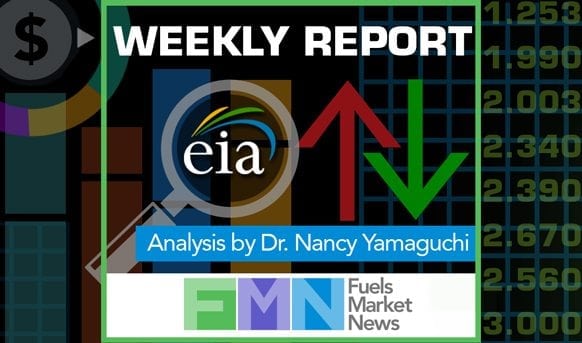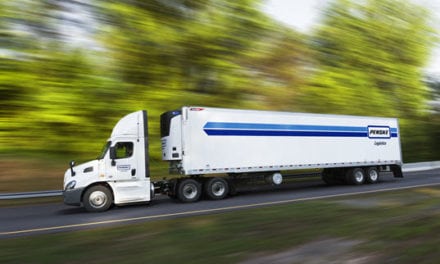Analysis by Dr. Nancy Yamaguchi
The U.S. Energy Information Administration (EIA) released its weekly data on diesel and gasoline retail prices for the week ended May 25, delayed because of Memorial Day. Retail prices for gasoline rose for the fourth consecutive week after a nine-week downward spiral. Diesel prices finally pulled out of their 19-week downward trek, which started the second week of January. The COVID-19 pandemic caused severe demand destruction, which now is beginning to reverse. The EIA publishes weekly “product supplied” data as its proxy for demand. These data show gasoline demand crashing from 9,696 barrels per day (kbpd) during the week ended March 13 to just 5,065 kbpd during the week ended April 3, a huge hit of 4,631 kbpd in just four weeks. That was the low point. Data for the week ended May 15 show that gasoline demand has crept back up to 6,790 kbpd. The demand recovery is not a smooth upward curve; this week’s data showed a downturn from 7,398 kbpd during the week ended May 8. The EIA points out that “product supplied” is not a precise measure of demand, but these data provide the most up-to-date numbers publicly available.
Diesel demand dropped sharply in response to COVID-19, and it now is recovering in fits and starts. The EIA reported that distillate fuel oil demand first plunged by 1,256 kbpd between the week ended March 13 and the week ended April 10, slumping from 4,013 kbpd to 2,757 kbpd in a four-week period. Diesel demand crept back up to 3,164 kbpd by the week ended April 24. Apparent demand weakened again during the week ended May 1, dropping to 3,129 kbpd. A rebound came during the week ended May 8, bringing demand to 3,818 mmbpd. The week ended May 15 saw diesel demand retreat to 3,668 kbpd.
U.S. apparent demand for total petroleum products appeared to have hit bottom at 13,797 kbpd for the week ended April 10, 2020. This was the lowest demand ever recorded since the EIA began publishing the series in November of 1990—nearly 30 years ago. Recall that U.S. oil product demand in January and February 2020 was over 20,000 kbpd before the COVID-19 pandemic hit. Total demand has been recovering, and it was reported at 16,586 kbpd for the week ended May 15. Demand recovery will be linked to economic recovery, which is expected to come in phases. The unemployment rate skyrocketed to 14.7% in April.
Comparing the most recent weekly data available (for the week ended May 15) with data from the week ended March 13 (before mandatory shelter-in-place orders began to take hold,) the data show that over a 10-week period, gasoline demand has crept back up to 70% of its March 13 level. Diesel demand has recovered to 91% of its March 13 level.

For the week ended May 25, retail prices for gasoline rose strongly by 8.2 cents/gallon. Retail prices for diesel increased slightly by 0.4 cents/gallon. Although this was only a fraction of a cent, it broke a 19-week streak of falling prices for diesel.
The national average price for gasoline was $1.960/gallon. This price was $0.862/gallon below the price for the same week one year ago. In February, retail prices for gasoline were higher than they had been a year earlier. Now, prices in four of the five PADDs are below the $2/gallon level, with only the West Coast PADD 5 having retail prices above $2/gallon. From late-November through early March, gasoline prices had been above their levels from last year. During the week ended March 2, retail gasoline prices were a mere 0.001 cent/gallon above last year’s level. The huge price declines since then have brought gasoline prices dramatically below their levels of last year.
Diesel prices also had been above last year’s level, but prices are now well below these levels. On a national average basis, the retail price for diesel averaged $2.390/gallon—76.1 cents/gallon lower than the price in the same week last year. Until the current week, retail prices for diesel had fallen for 19 consecutive weeks, shedding a total of 69.3 cents/gallon.
Collapse of Futures Prices and Retail Price Outlook
During the week May 18 to May 22, West Texas Intermediate (WTI) crude oil futures prices recovered significantly by $4.14/b (13.9%.) This was the fourth week of price recovery following a volatile downward trend punctuated with sharp collapses. This included the historical event of seeing WTI crude futures for May delivery close at -$37.63/b on April 20. Infrastructure limitations and loss of liquidity had caused a collapse of never-before-seen proportions, where traders were forced to pay others to accept their contracts rather than take physical delivery of crude oil. During this collapse, June delivery contracts had remained in the $20-$22/b range, allowing many to conclude that this was closer to the “true” value of WTI crude. Crude futures prices soon regained this level. Currently, WTI prices are hovering in the $33-$34/b range. This is prompting the question: Are oil prices rising too much, too soon? The month of May began with partial re-opening of economic activities. The medical community is concerned about increased outbreaks of the coronavirus where re-opening is not done with proper care. The public appears eager to grip positive news, and many attended social outings over the Memorial Day weekend, feeding into the oil price rally.
During the week of May 18 to May 22, gasoline futures prices recovered by 7.5 cents (7.7%.) Diesel futures prices rose by 6.68 cents/gallon (7.3%.) While the relationship between futures prices and retail prices is not immediate or one-for-one, the current week’s rise of futures prices suggests that gasoline and diesel retail prices will also strengthen in the coming week. The supply overhang remains massive, however, so a major price rally is unlikely.
Retail Diesel Prices
The week ended May 25 brought a 0.4 cents/gallon increase in the retail price for diesel. Although this was a small increase, it broke a downward price trend that had lasted for 19 consecutive weeks—every week this calendar year following the first week of January. This year to date, diesel prices have fallen by a cumulative 68.9 cents/gallon. In the autumn of 2019, retail diesel prices had been below the $3/gallon mark until the attacks on Saudi Arabian oil facilities in mid-September 2019. They rose at that time, and they remained above the $3/gallon mark until the week ended February 3, 2020. Prices then continued to slide. For the current week, retail diesel prices recovered modestly by 0.4 cents to arrive at an average price of $2.390/gallon. For the current week, diesel prices rose slightly in all PADDs except for the Gulf Coast PADD 3, where prices were unchanged. The national average price for the week was 76.1 cents/gallon below where it was during the same week last year.
In the East Coast PADD 1, diesel prices rose by 0.7 cents to settle at an average price of $2.498/gallon. Within PADD 1, New England prices rose by 0.4 cents to average $2.624/gallon. Central Atlantic diesel prices declined by 0.1 cent to average $2.666/gallon. Lower Atlantic prices rose by 1.4 cents to an average price of $2.359/gallon. PADD 1 prices were 66.6 cents/gallon below their levels for the same week last year.
In the Midwest PADD 2 market, retail diesel prices edged up by 0.1 cent to average $2.230/gallon. Prices were 80.8 cents below their level for the same week last year. PADD 2 joined PADD 3 during the week ended June 17, 2019, in having diesel prices fall below $3/gallon. Prices subsequently fell below $3/gallon in PADD 4 and PADD 1. Five weeks ago, PADD 5 prices also slid below the $3/gallon mark.
In the Gulf Coast PADD 3, retail diesel prices remained unchanged at an average of $2.175/gallon. PADD 3 continues to have the lowest diesel prices among the PADDs, currently 21.5 cents below the U.S. average. Prices were 71.8 cents below their level for the same week in the previous year.
In the Rocky Mountains PADD 4 market, retail diesel prices rose by 1.0 cent to arrive at an average of $2.348/gallon. PADD 4 prices were 83.3 cents lower than for the same week in the prior year.
In the West Coast PADD 5 market, retail diesel prices rose by 1.5 cents to average $2.902/gallon. This was the largest price increase among the PADDs. PADD 5 prices were 88 cents below their level from last year. Until December 2019, PADD 5 had been the only district where diesel prices were higher than they were in the same week last year. Subsequently, prices rose until this was true in all other PADDs. Prices have fallen dramatically, and the national average price is now well below its level of last year. PADD 5 prices excluding California rose by 1.8 cents to average $2.561/gallon. This price was 77.7 cents below the retail price for the same week last year. California diesel prices rose by 1.1 cents to reach an average price of $3.182/gallon. Until the week ended June 24, 2019, California had been the only major market where diesel prices were above $4/gallon, where they had been for nine weeks. California prices retreated below $4/gallon from July through October, rose above $4/gallon again during the first three weeks of November, and declined since then until just this past week. California diesel prices were 95.2 cents lower than they were at the same week last year.



Retail Gasoline Prices
The COVID-19 pandemic is having a massive impact on the U.S. gasoline market. U.S. retail gasoline prices fell below the $2/gallon threshold during the week ended April 6, and they have remained below $2/gallon for six weeks despite the price recovery seen during the past four weeks. Average retail prices rose significantly by 8.2 cents/gallon to average $1.960/gallon during the current week ended May 25. Prices rose in all PADDs. Retail gasoline prices for the current week were 86.2 cents per gallon lower than they were one year ago. Until November, gasoline prices had been below their levels of last year. Prices then rose to surpass last year’s levels in all PADDs. The downhill price slide changed this, making gasoline a bargain. It has been over four years since the average retail price for gasoline was below the $2/gallon mark.
Looking back at historic prices, gasoline prices hit a peak of $2.903/gallon during the week ended October 8, 2018. Prices then slid downward for 14 weeks in a row, shedding a total of 66.6 cents per gallon. In the next 17 weeks, prices marched back up by 66 cents/gallon. Prices came very close to the peak they hit in early October 2018. However, the months of May and the June 2019 brought an easing of prices amounting to 23.3 cents per gallon. The week ended July 1 reversed that downward trend and sent prices up once again. The COVID-19 pandemic is causing a severe contraction in demand as people shelter in place, and many jobs have been lost. The U.S. Bureau of Labor Statistics reported in its monthly Employment Situation report, also known as the “Jobs Report,” that the U.S. unemployment rate surged to 14.7% in April. According to EIA data, gasoline demand during the week ended May 15 was about 30% lower than it had been during the week ended March 13.
For the current week ended May 25, East Coast PADD 1 gasoline retail prices rose by 7.3 cents to arrive at an average of $1.906/gallon. Eight weeks ago, PADD 1 joined PADDs 2 and 3 in having retail prices drop below the $2/gallon line. This week’s average price was 79 cents/gallon below where it was during the same week last year. Within PADD 1, New England prices increased by 5.9 cents to average $1.937/gallon. Central Atlantic market prices rose by 4.5 cents, reaching an average of $2.082/gallon. Prices in the Lower Atlantic market jumped by 9.5 cents to average $1.787/gallon.
In the Midwest PADD 2 market, retail gasoline prices rose by 10.2 cents to average $1.885/gallon. Last month, PADD 2 prices had slumped below prices in the U.S. Gulf Coast PADD 3 market, a rare occurrence. PADD 2 prices for the week were 82.7 cents/gallon lower than they were for the same week last year.
In the Gulf Coast PADD 3 market, gasoline prices rose by 5.7 cents to average $1.598/gallon. Ten weeks ago, PADD 3 was the first region where retail prices fell below the $2/gallon level. It was joined by PADD 2, then by PADD 1, and then by PADD 4. PADD 3 usually has the lowest average prices among the PADDs. PADD 3 prices for the week were 87.5 cents/gallon lower than for the same week last year.
In the Rocky Mountains PADD 4 market, gasoline pump prices surged by 17.1 cents, reaching at an average price of $1.991/gallon. This was the largest price hike among the PADDs. This week’s PADD 4 prices were 98.8 cents/gallon lower than at the same time last year.
In the West Coast PADD 5 market, retail gasoline prices rose by 7.3 cents to average $2.552/gallon. PADD 5 typically has the highest retail prices for gasoline, and until mid-March it had been the only PADD where retail gasoline prices stayed above $3/gallon. Prices this week were a hefty $1.080/gallon lower than last year’s price. Prices excluding California rose by 6.9 cents to average $2.298/gallon, which was $1.037/gallon below last year’s price. California prices recovered strongly by 7.8 cents to average $2.766/gallon. California had been the last state where gasoline prices had remained above the $3/gallon line, but this changed the week ended March 30. On Thursday March 19, California led the U.S. by taking the dramatic step of ordering a statewide shelter-in-place to combat the spread of COVID-19. This order affected approximately 40 million people, and it caused a dramatic contraction in fuel demand. California retail gasoline prices were a massive $1.112 per gallon below their levels from the same week last year.












